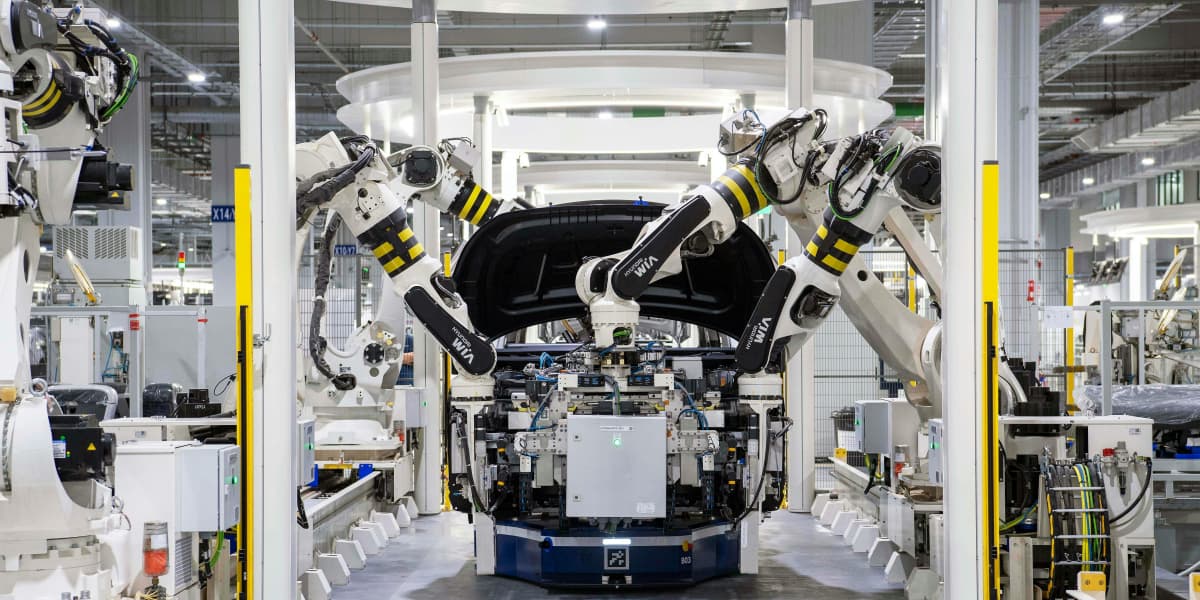Guide d'éclairage LED industriel pour les usines

La hausse des factures d'énergie, les normes de sécurité strictes et les arrêts de production obligent les responsables d'installations à repenser l'éclairage.
Ce guide pratique de l'éclairage LED industriel explique ce que sont les systèmes LED industriels, les normes et technologies mondiales qui les sous-tendent, comment choisir les luminaires adaptés, concevoir des agencements efficaces et sélectionner des fabricants fiables.
Vous trouverez des spécifications pratiques, des listes de contrôle comparatives et des conseils axés sur le retour sur investissement pour réduire les coûts énergétiques, améliorer la visibilité et la sécurité, et garantir la conformité de vos opérations. Poursuivez votre lecture pour élaborer un plan d'éclairage fiable pour votre usine, votre entrepôt ou votre atelier.
Annuaire:
1. Qu'est-ce que l'éclairage LED industriel ?
2. Comprendre les normes mondiales d'éclairage industriel
3. Quelles technologies alimentent l'éclairage LED industriel moderne ?
4. Quels sont les avantages de l'utilisation des éclairages LED industriels ?
5. De quel type d'éclairage LED industriel avez-vous besoin ?
6. Comment concevoir un agencement d'éclairage LED industriel efficace ?
7. Comment choisir le meilleur fabricant de luminaires industriels LED ?
8. L'avenir de l'éclairage industriel à LED — Quelle est la prochaine étape ?
1. Qu'est-ce que l'éclairage LED industriel ?
L'éclairage industriel à LED désigne les systèmes d'éclairage haute performance conçus pour les environnements de travail exigeants tels que les usines, les entrepôts, les chaînes de production et les grands ateliers. Contrairement à l'éclairage de bureaux ou de commerces, qui privilégie le confort visuel et l'esthétique, l'éclairage industriel mise sur la durabilité , la luminosité et la sécurité dans des conditions difficiles comme la poussière, les vibrations et les variations de température.
Le terme « industriel » signifie généralement que l'éclairage doit supporter un fonctionnement intensif — souvent 24 heures sur 24, à des hauteurs de montage élevées et sur de vastes zones où une visibilité précise est essentielle à la productivité et à la prévention des accidents.
Comparées aux lampes fluorescentes ou à halogénures métalliques traditionnelles, les lampes LED industrielles offrent un flux lumineux plus élevé par watt, un allumage instantané et une durée de vie nettement supérieure. Elles nécessitent également moins d'entretien, réduisant ainsi les temps d'arrêt dans les installations de production.

L'éclairage LED industriel se présente sous plusieurs formes principales :
Luminaires pour grandes hauteurs – idéaux pour les hauts plafonds des entrepôts et des usines.
Luminaires pour baies basses – utilisés dans les espaces réduits comme les ateliers ou les chaînes de montage.
Projecteurs LED industriels – conçus pour les cours extérieures, les zones de chargement ou les périmètres de bâtiments.
Éclairage d'usine et d'atelier – des systèmes sur mesure qui allient efficacité, sécurité et luminosité uniforme pour des tâches spécifiques.
En bref, l'éclairage industriel à LED constitue la base d'un espace de travail plus sûr, plus efficace et plus rentable — une étape clé vers des opérations industrielles plus intelligentes.
2. Comprendre les normes mondiales d'éclairage industriel
L'éclairage industriel à LED est régi par un ensemble de normes internationales qui définissent les exigences en matière de luminosité, d'uniformité et de sécurité de l'éclairage sur les lieux de travail. Ces normes garantissent un éclairage favorisant la productivité, le confort visuel et la sécurité au travail – des objectifs essentiels pour toute installation industrielle.
2.1 Principales normes internationales
(1) I ES (Illuminating Engineering Society, États-Unis)
Publie le IES Lighting Handbook (11e édition, 2020) , souvent appelé la « Bible de l'éclairage ». Il fournit les bases de toutes les pratiques de conception d'éclairage, y compris les tests photométriques, le contrôle de l'éblouissement et l'efficacité énergétique.
IES RP-7 (Recommandations pour l'éclairage industriel) : Fournit des directives détaillées sur les niveaux d'éclairement, l'uniformité et le placement des luminaires dans les installations industrielles. → Source : IES Lighting Handbook, 11e édition (2020), IES RP-7-17.

(2) CIE (Commission internationale de l'éclairage)
La CIE élabore des normes internationales relatives à la qualité de l'éclairage, au rendu des couleurs et à la perception visuelle humaine. Sa publication phare, la CIE S 008/E:2001 – Éclairage des lieux de travail – , a influencé de nombreuses normes régionales. → Source : Bureau central de la CIE, Vienne, Autriche.
(3) ISO 8995-1:2024 (CIE S 008/E:2001, mise à jour)
La dernière norme conjointe ISO/CIE remplace l'ISO 8995-1:2002. Elle spécifie les exigences en matière de performance visuelle et d'éclairage ergonomique pour les postes de travail intérieurs, en mettant l'accent sur l'uniformité, les limites d'éblouissement et la visibilité des tâches. → Source : Organisation internationale de normalisation (ISO), édition 2024.

(4) EN 12464-1:2021 (Europe)
Définit les limites minimales d'éclairement, d'uniformité, de rendu des couleurs et d'UGR (Unified Glare Rating) pour les intérieurs industriels dans toute l'UE. → Source : Comité européen de normalisation (CEN).
(5) OSHA 29 CFR 1926.56 (États-Unis)
Définit des niveaux d'éclairage minimaux pour différentes zones de travail afin de garantir la sécurité des travailleurs. → Source : Département du Travail des États-Unis, Administration de la sécurité et de la santé au travail.
2.2 Niveaux d'éclairement recommandés
Domaine d'application | Lux recommandé (lx) | Référence standard |
Allées d'entrepôt (stockage) | 100–200 lx | EN 12464-1:2021 / IES RP-7-17 |
chaînes d'assemblage ou de production | 300–750 lx | ISO 8995-1:2024 / CIE S 008/E |
zones de précision ou d'inspection | 750–1000 lx | IES RP-7-17 / CIE S 008/E |
zones de chargement extérieures | 100–300 lx | IES RP-7-17 / OSHA 29 CFR 1926.56 |
2.3 Paramètres de qualité d'éclairage
IRC (Indice de rendu des couleurs) : Recommandé ≥80 pour une discrimination précise des couleurs dans les environnements industriels.
Température de couleur : Blanc neutre à froid (4000–6000K) améliore la concentration et la visibilité dans les espaces de production.
Indice de luminosité unifié (UGR) : doit être inférieur à 22 afin de minimiser l’éblouissement inconfortable et la fatigue visuelle. → Source : EN 12464-1:2021, ISO 8995-1:2024.
2.4 Marques de certification et de conformité
Certification | Région | Ce que cela confirme |
UL (Laboratoires des assureurs) | NOUS | Confirme la conformité aux normes de sécurité électrique et incendie. |
CE (Conformité Européenne) | UE | Conforme aux directives européennes en matière de sécurité, de santé et de performance. |
DLC (Consortium DesignLights) | Amérique du Nord | Vérifie l'efficacité énergétique ; souvent exigé pour l'obtention de rabais. |
RoHS (Restriction des substances dangereuses) | Mondial | Garantit que les produits sont exempts de matières dangereuses comme le plomb ou le mercure. |
Le respect de ces normes garantit que les systèmes d'éclairage LED industriels sont fiables, efficaces et conformes aux exigences de sécurité internationales.
Ceramiclite respecte ces normes internationales pour fournir des solutions d'éclairage qui répondent aux attentes professionnelles en matière de performance et de conformité dans le monde entier.
3. Quelles technologies alimentent l'éclairage LED industriel moderne ?
L'éclairage industriel moderne à LED associe l'optique, l'électronique et des systèmes de contrôle intelligents pour fournir un éclairage puissant, durable et efficace, même dans les conditions de travail les plus difficiles. Les technologies clés suivantes définissent les systèmes d'éclairage industriel haute performance actuels.
3.1 Puces LED à haut rendement lumineux et optique avancée
L'élément fondamental de tout éclairage industriel à LED est sa puce LED. Les principaux fabricants, tels que Cree, Nichia et Osram, produisent des puces à haut flux lumineux et à haut rendement (généralement 150 à 200 lm/W) qui garantissent une luminosité maximale pour une consommation d'énergie minimale.
Les systèmes optiques secondaires avancés, tels que les lentilles et les réflecteurs moulés avec précision, contribuent à façonner et à diriger le faisceau, minimisant ainsi l'éblouissement et maximisant l'uniformité dans de grands espaces comme les entrepôts et les halls d'assemblage.
3.2 Moteurs efficaces et dissipation de chaleur
Les drivers LED régulent le courant pour maintenir un flux lumineux constant et protéger le système des fluctuations de tension. Les drivers industriels sont souvent compatibles avec la gradation 0-10 V ou DALI et présentent un facteur de puissance supérieur à 0,95 pour une meilleure stabilité énergétique.
La gestion thermique est tout aussi cruciale. Les boîtiers en aluminium moulé sous pression, les caloducs et les dissipateurs thermiques à ailettes multiples assurent une dissipation thermique efficace, prolongeant ainsi la durée de vie de la LED à plus de 50 000 heures.
3.3 Conception sans scintillement et à taux de rafraîchissement élevé
Le scintillement dû à des drivers de mauvaise qualité peut provoquer une fatigue oculaire chez les travailleurs et des interférences avec les équipements. Les luminaires LED industriels utilisent désormais des drivers à courant constant et à haute fréquence (généralement ≥ 25 kHz) pour fournir un éclairage stable et sans scintillement .
This technology not only improves visual comfort but also ensures camera-friendly performance for machine vision systems and high-speed operations.
3.4 IP and IK Protection for Harsh Environments
Industrial spaces often face dust, moisture, and impact risks. IP (Ingress Protection) and IK (Impact Resistance) ratings define a luminaire’s durability:
IP65–IP67: Dust-tight and water-resistant, ideal for factories or outdoor yards.
IK08–IK10: Resistant to strong mechanical impacts.
Proper sealing, silicone gaskets, and reinforced housings allow reliable operation in environments with oil mist, vibration, or high humidity.
→ Source: IEC 60529 (IP Rating) & IEC 62262 (IK Code).
3.5 Smart Control Compatibility (DALI, Zigbee, Bluetooth, IoT)
Modern industrial LED lights increasingly integrate intelligent control systems.
DALI (Digital Addressable Lighting Interface): Enables precise dimming and zoning control.
Zigbee and Bluetooth Mesh: Allow wireless connectivity for large-scale facility management.
IoT Platforms: Integrate sensors for occupancy, daylight harvesting, and energy monitoring.
Such technologies support smart factory and Industry 4.0 applications—where lighting responds automatically to operational needs, optimizing both comfort and efficiency.
By combining optical precision, electronic stability, mechanical protection, and smart control, modern industrial LED lighting achieves a balance of brightness, reliability, and intelligence — transforming lighting from a passive fixture into an active component of smart industrial infrastructure.
4. What Are the Benefits of Using Industrial LED Lights?
Upgrading to industrial LED lighting is no longer just about modernizing a facility—it’s a proven way to reduce operating costs, improve safety, and achieve sustainability goals. The advantages of LEDs over traditional lighting (like metal halide, fluorescent, or HPS lamps) are measurable and long-term.
4.1 Energy Efficiency and Lower Carbon Footprint
Industrial LED lights convert up to 90–95% of input energy into visible light, compared with only 60–70% for high-intensity discharge (HID) lamps. This results in energy savings of 50–70%, depending on the application.
Many facilities also adopt smart dimming controls and motion sensors, further cutting unnecessary power consumption. Lower energy use directly translates into reduced CO₂ emissions — a key metric in corporate sustainability and ESG reporting.
4.2 Longer Lifespan and Minimal Maintenance
Industrial-grade LEDs typically last 50,000–100,000 hours, compared with 10,000–20,000 hours for fluorescent and metal halide lamps.
Because they contain no filaments or fragile glass, LEDs maintain brightness longer and are less prone to breakage from vibration or impact.
This significantly lowers maintenance frequency and replacement labor costs — especially in high-ceiling environments like warehouses or production halls.
4.3 Brighter and Safer Work Environments
LEDs deliver instant full brightness and superior color rendering (CRI ≥80), improving visibility of tools, labels, and safety markings.
Consistent illumination helps reduce accidents caused by shadows or glare, while flicker-free operation prevents worker eye strain and fatigue.

4.4 Stable Performance in Harsh Conditions
Unlike traditional lamps that degrade in cold or humid environments, industrial LEDs perform reliably between –30°C and +50°C and maintain stable lumen output in high humidity.
Sealed housings with IP65–IP67 protection prevent dust and moisture ingress, making them suitable for factories, foundries, and outdoor facilities.
4.5 ROI and Payback Period
The typical payback period for converting to industrial LED lighting ranges from 1.5 to 3 years, depending on energy costs, operating hours, and regional rebates. After payback, the continued energy and maintenance savings contribute directly to long-term ROI.
By combining high efficiency, durability, and safety, industrial lighting delivers both operational and financial value. It’s not just a lighting upgrade — it’s an investment in productivity, sustainability, and smarter facility management.
5. Which Type of Industrial LED Light Do You Need?
Choosing the right industrial LED light depends on installation height, lighting layout, and work environment. Below are the main categories used across modern industrial facilities — each designed for specific applications and performance needs.
(1) High Bay LED Lights – For Tall Warehouses and Factories
High bay lights are designed for ceilings above 20 feet (6 meters). They provide powerful, uniform illumination for large spaces such as manufacturing workshops, distribution centers, and aircraft hangars. Their deep reflectors and high lumen output ensure clear visibility even from long mounting distances.
Ceramiclite HB01 LED High Bay Light boasts a high luminous efficiency of 160lm/W and an extended lifespan of 102,000 hours (meeting the L80B10 standard at 35℃). It features a protection rating of IP67/IP69K/IK08 and comes with an 8-year warranty.

(2) Low Bay LED Lights – For Mid-Height Industrial Spaces
Low bay lights are used in areas with ceiling heights between 10–20 feet (3–6 meters), such as assembly halls, garages, and small warehouses. They offer wide-beam optics to distribute light evenly without glare, improving comfort and visual accuracy for workers.
(3) LED Shop Lights – For Workstations and Production Lines
Shop lights are typically installed above workbenches, inspection areas, or assembly tables. They emphasize brightness and color accuracy to enhance precision tasks. Slim housing and linkable designs make them easy to mount in rows, ideal for manufacturing or maintenance workshops as LED workshop lights.
(4) LED Strip Lights – For Linear or Continuous Lighting Needs
Strip lights provide linear illumination for corridors, conveyor belts, or narrow aisles. Their continuous layout eliminates dark zones, improving safety in logistics and assembly environments. They are also used under shelves or inside machinery for localized task lighting.
(5) LED Flood Lights – For Outdoor Industrial Yards and Perimeters
Flood lights are built for durability and weather resistance. They illuminate loading docks, parking lots, and construction areas with high-intensity beams, ensuring both visibility and security. Industrial-grade models often feature IP65+ protection and wide operating temperature ranges.
Each of these LED categories serves a distinct role within the industrial ecosystem — from overhead illumination to focused task lighting and exterior security.
When selecting industrial LED light fixtures, consider mounting height, coverage area, environmental conditions, and energy goals. Matching the right LED type to each application ensures optimal visibility, safety, and long-term efficiency for your facility.
6. How to Design an Efficient Industrial LED Lighting Layout?
A well-designed lighting layout is essential to achieve both energy efficiency and worker safety in industrial environments. The goal is to deliver uniform brightness with minimal shadows or glare, ensuring that every area of the workspace is adequately lit without wasting power.
(1) Assess the Space and Ceiling Height
The first step is understanding the dimensions of the facility. Ceiling height determines fixture type and beam angle — for example, high bay lights suit ceilings above 6 meters, while low bay or linear lights are ideal for mid-height areas. Taller spaces require narrower beam angles to project light further, whereas lower ceilings benefit from wider beams for uniform spread.
(2) Plan Fixture Spacing and Mounting Arrangement
Incorrect spacing can create uneven lighting or dark spots. As a general guideline, the distance between fixtures should be about 1 to 1.5 times the mounting height. For example, if lights are mounted 8 meters high, spacing them 8–12 meters apart often provides balanced coverage. Reflective surfaces such as white walls or bright ceilings can help amplify illumination and reduce the number of fixtures needed.
(3) Consider Beam Angle and Reflectance
Beam angle controls how light is distributed across the floor. Narrow beams concentrate brightness in small areas, suitable for tall shelves or high ceilings. Wide beams work better in open areas like workshops. Reflectance from walls, floors, and machinery also affects overall brightness — surfaces with higher reflectivity improve lighting efficiency.
(4) Use Lighting Simulation Tools
Before installation, lighting design software (such as Dialux or Relux) can simulate illumination patterns, predict lux levels, and optimize fixture placement. These simulations ensure compliance with local standards for workspace lighting and help identify potential glare or shadow zones.
(5) Combine Fixture Types for Layered Illumination
A single light type rarely meets all industrial needs. Combining high bay lights for general illumination, task lights for workbenches, and flood lights for outdoor or safety zones creates a layered system that balances brightness, comfort, and energy use.
By aligning fixture choice, spacing, and simulation-based design, industrial facilities can achieve a well-lit, energy-efficient, and visually comfortable environment that enhances both safety and productivity.
7. How to Choose the Best LED Industrial Lights Factory?
Selecting a trustworthy industrial LED lighting factory is critical to ensuring long-term performance, safety, and return on investment. A well-qualified manufacturer provides not just lighting products, but complete technical assurance and service reliability.
(1) Verify Factory Qualification and Production Capability
A reliable LED lighting factory should have its own production line, R&D department, and quality control system. This guarantees consistency in components, assembly, and testing. Unlike resellers who outsource manufacturing, factory-direct suppliers can control every stage of production — from LED chip sourcing to driver calibration — ensuring higher product reliability and stable supply.
(2) Check Certification and Compliance
Authentic quality always comes with recognized certifications. Look for CE, RoHS, UL, ETL, and CB marks, which indicate compliance with international electrical and safety standards. These certifications confirm that the lighting products have passed rigorous performance and safety testing — an essential factor for industrial applications.
(3) Request Samples and Validate Test Reports
Before placing large orders, sample testing is the most direct way to evaluate brightness, color consistency, heat management, and build quality. Reputable manufacturers will provide IES photometric files, LM-79/LM-80 test reports, and warranty documentation upon request.
(4) Evaluate Technical Support and Customization Capability
Every industrial site has unique lighting requirements. Choose a supplier capable of custom design, DIALux simulation support, and flexible mounting solutions. Technical expertise in smart controls (e.g., DALI, Zigbee) and energy modeling is also a sign of a mature manufacturer.
(5) Compare Warranty and After-Sales Service
Warranty length reflects confidence in product durability. The industrial standard is typically 5 years, but leading manufacturers offer 8–10 years. Comprehensive after-sales service and fast response are equally important for long-term operations.
Ceramiclite is a professional industrial LED lighting manufacturer integrating R&D, production, and global sales. The company holds CE, RoHS, CB, CCC, UL, and ETL certifications and provides up to 10 years of warranty for select products — a commitment that exceeds most competitors.
Explore Ceramiclite’s professional-grade industrial lighting solutions today!
8. Future of Industrial LED Lighting — What’s Next?
Industrial LED lighting is evolving from simple illumination to intelligent, data-driven infrastructure that supports energy efficiency, safety, and productivity goals. The next generation of lighting systems will redefine how factories and warehouses operate.
(1) Smart Industrial Lighting Systems
The most significant innovation is the adoption of smart sensors, IoT platforms, and automated control systems. These allow lights to adjust brightness based on motion, daylight, or occupancy levels — reducing unnecessary power use. Integration with protocols like DALI-2, Zigbee, and Bluetooth Mesh enables centralized control and remote monitoring, helping facility managers improve energy efficiency by up to 60% (source: U.S. Department of Energy, 2024).
(2) Intégration aux énergies renouvelables
Les usines combinent de plus en plus les systèmes LED avec des solutions d'énergie solaire et renouvelable . Les contrôleurs intelligents permettent de synchroniser les programmes d'éclairage avec la production d'énergie sur site, aidant ainsi les entreprises à atteindre leurs objectifs de neutralité carbone et de critères ESG tout en réduisant leurs coûts d'exploitation.
(3) Éclairage centré sur l'humain pour de meilleurs environnements de travail
Au-delà des économies d'énergie, la conception future de l'éclairage privilégiera le confort humain et le respect du rythme circadien .
_thumb.jpg)

